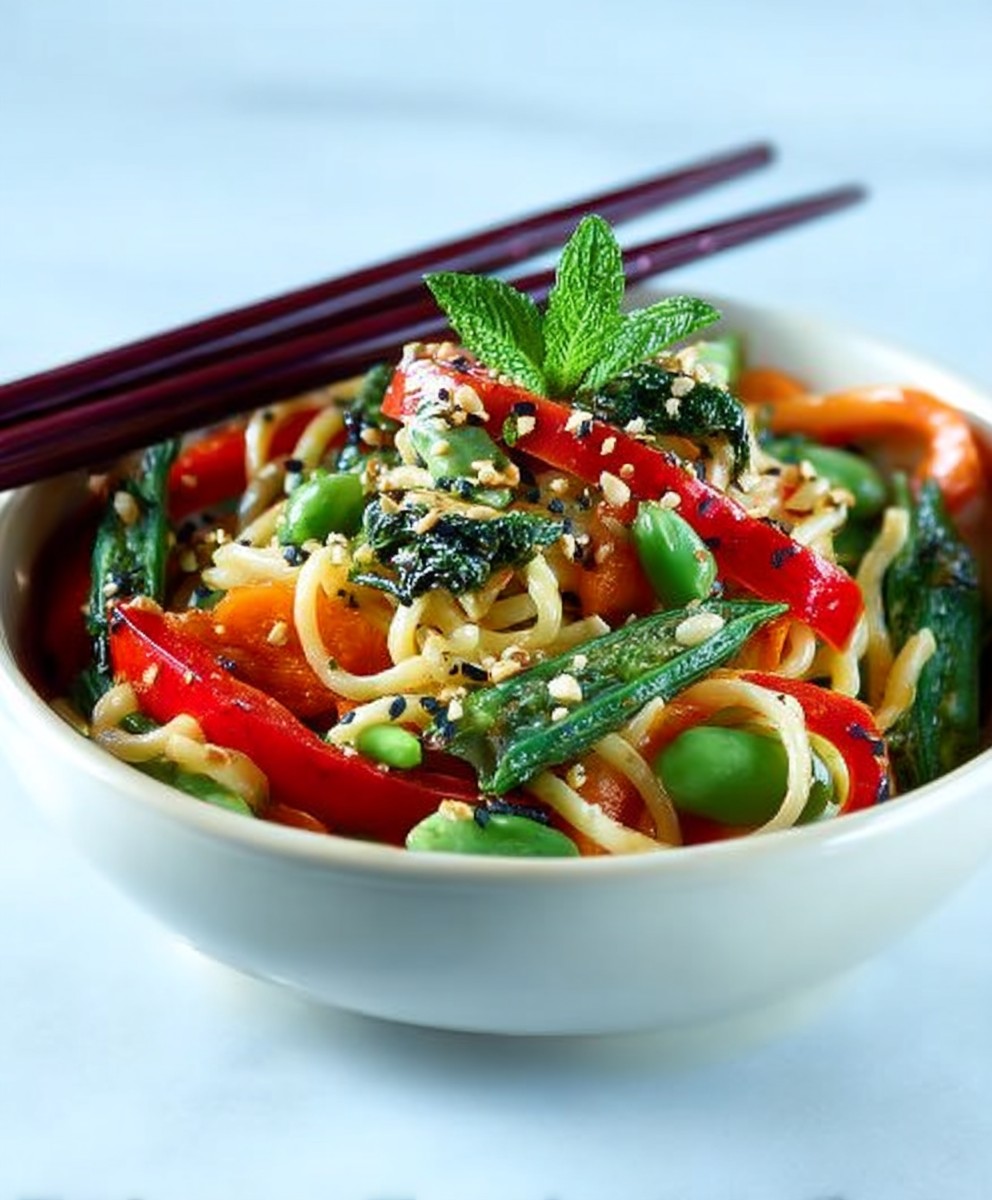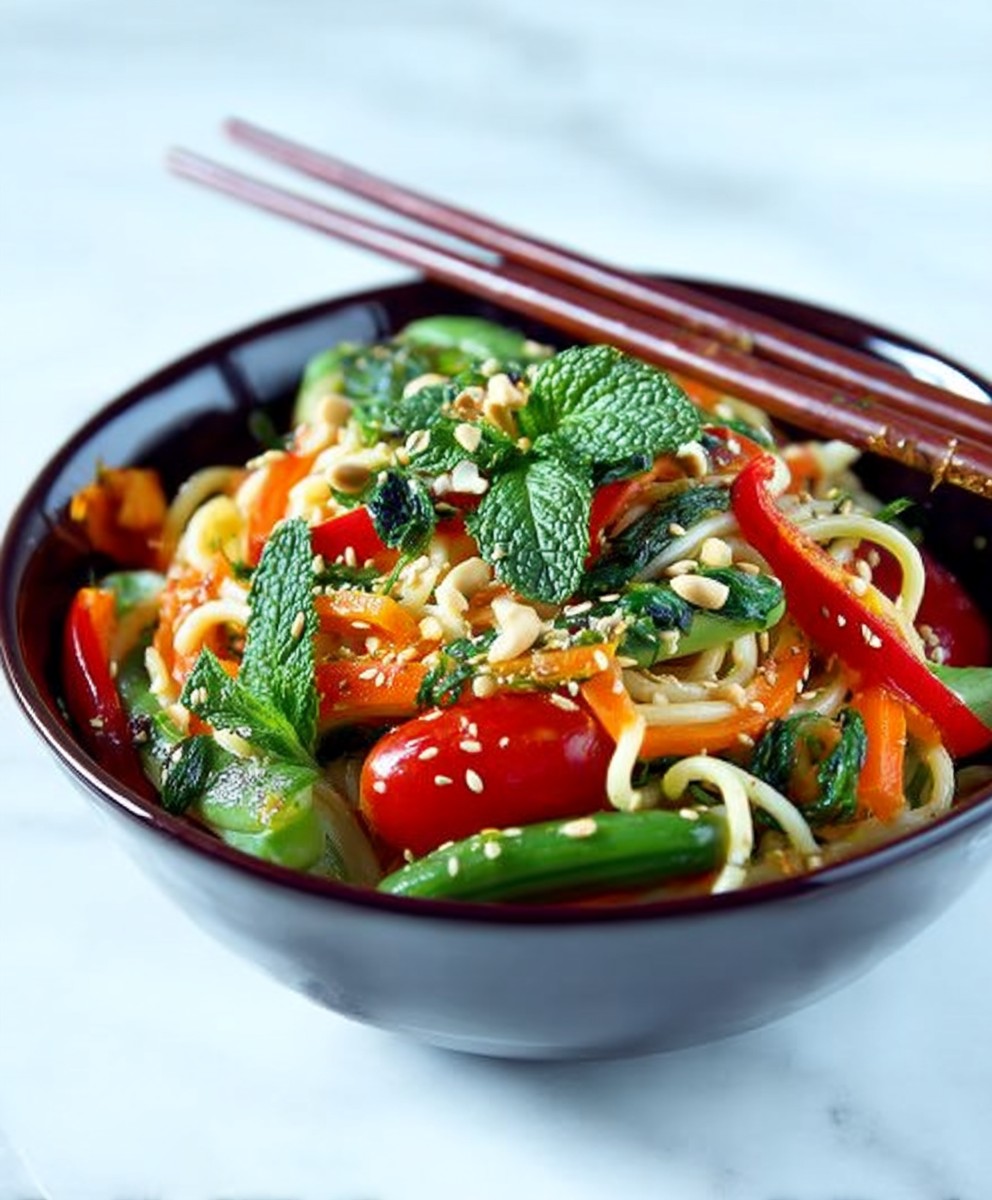Asian vegetable pasta salad: Prepare to embark on a culinary adventure that will tantalize your taste buds and leave you craving more! Imagine a vibrant medley of crisp, colorful vegetables, perfectly cooked pasta, and a dressing that’s both sweet and savory, all harmonizing in a symphony of flavor. This isn’t just a salad; it’s an experience.
While the exact origins of Asian vegetable pasta salad are difficult to pinpoint, it’s a delightful fusion of Eastern and Western culinary traditions. Pasta, a staple in Italian cuisine, meets the fresh, vibrant flavors of Asian vegetables and dressings, creating a dish thats both familiar and excitingly new. It’s a testament to the beauty of culinary innovation, where different cultures come together to create something truly special.
What makes this salad so irresistible? It’s the perfect balance of textures the slight chew of the pasta, the satisfying crunch of the vegetables, and the smooth, flavorful dressing that ties it all together. People adore this dish because it’s incredibly versatile, making it ideal for potlucks, picnics, or a quick and easy weeknight meal. Plus, its a fantastic way to incorporate more vegetables into your diet without sacrificing flavor. Get ready to discover your new favorite salad!
Ingredients:
- Pasta: 1 pound of your favorite pasta shape (rotini, penne, or farfalle work well)
- Broccoli florets: 1 ½ cups, cut into bite-sized pieces
- Carrots: 1 cup, julienned or thinly sliced
- Red bell pepper: 1 cup, thinly sliced
- Snow peas: 1 cup, trimmed
- Edamame: 1 cup, shelled
- Green onions: ½ cup, thinly sliced
- Cilantro: ¼ cup, chopped
- Sesame seeds: 2 tablespoons, toasted
- For the Dressing:
- Soy sauce: ¼ cup
- Rice vinegar: 3 tablespoons
- Sesame oil: 2 tablespoons
- Honey: 2 tablespoons
- Ginger: 1 tablespoon, freshly grated
- Garlic: 2 cloves, minced
- Red pepper flakes: ¼ teaspoon (or more, to taste)
- Vegetable oil: ¼ cup
Preparing the Pasta and Vegetables:
- Cook the Pasta: Bring a large pot of salted water to a boil. Add the pasta and cook according to package directions until al dente. This usually takes about 8-10 minutes. Be careful not to overcook it, as it will become mushy in the salad.
- Blanch the Broccoli: While the pasta is cooking, prepare an ice bath. In a separate pot, bring water to a boil. Add the broccoli florets and blanch for 2-3 minutes, until bright green and slightly tender-crisp. Immediately transfer the broccoli to the ice bath to stop the cooking process. This will help retain its vibrant color and crisp texture.
- Prepare the Remaining Vegetables: While the broccoli is cooling, julienne or thinly slice the carrots and red bell pepper. Trim the snow peas. If using frozen edamame, cook according to package directions (usually steaming or microwaving). Thinly slice the green onions and chop the cilantro.
- Drain and Rinse the Pasta: Once the pasta is cooked, drain it in a colander. Rinse it with cold water to stop the cooking process and remove excess starch. This will prevent the pasta from sticking together.
- Drain the Broccoli: Drain the blanched broccoli from the ice bath and pat it dry with paper towels. This will prevent the salad from becoming watery.
Making the Asian-Inspired Dressing:
- Combine the Base Ingredients: In a medium bowl, whisk together the soy sauce, rice vinegar, sesame oil, honey, grated ginger, minced garlic, and red pepper flakes. The honey adds a touch of sweetness that balances the savory flavors of the soy sauce and sesame oil. The ginger and garlic provide a pungent aroma and flavor, while the red pepper flakes add a subtle kick.
- Emulsify the Dressing: Slowly drizzle in the vegetable oil while whisking continuously. This will emulsify the dressing, creating a smooth and creamy texture. The vegetable oil helps to bind the ingredients together and adds richness to the dressing. Continue whisking until the dressing is well combined and slightly thickened.
- Taste and Adjust: Taste the dressing and adjust the seasonings as needed. If you prefer a sweeter dressing, add a little more honey. If you like it spicier, add more red pepper flakes. If it’s too salty, add a splash of rice vinegar. Remember that the flavors will meld together as the salad sits, so it’s better to err on the side of slightly under-seasoning.
Assembling the Asian Vegetable Pasta Salad:
- Combine the Ingredients: In a large bowl, combine the cooked pasta, blanched broccoli, julienned carrots, sliced red bell pepper, snow peas, edamame, sliced green onions, and chopped cilantro. Make sure the bowl is large enough to accommodate all the ingredients without overcrowding.
- Pour the Dressing: Pour the Asian-inspired dressing over the pasta and vegetables.
- Toss Gently: Gently toss the salad to coat all the ingredients evenly with the dressing. Be careful not to over-mix, as this can cause the pasta to break apart. You want the dressing to be distributed throughout the salad without making it soggy.
- Garnish and Serve: Sprinkle the toasted sesame seeds over the salad. These add a nutty flavor and a pleasant crunch. You can also add other garnishes, such as chopped peanuts or almonds, for extra texture and flavor.
- Chill (Optional): For the best flavor, cover the salad and refrigerate it for at least 30 minutes before serving. This allows the flavors to meld together and the salad to chill. However, you can also serve it immediately if you’re short on time.
Tips and Variations:
- Protein Power: Add grilled chicken, shrimp, or tofu for a heartier salad. Marinate the protein in a similar Asian-inspired sauce before grilling or pan-frying for extra flavor.
- Vegetable Variety: Feel free to substitute or add other vegetables, such as bean sprouts, water chestnuts, or shiitake mushrooms. Just make sure to adjust the cooking time accordingly.
- Noodle Alternatives: Experiment with different types of noodles, such as soba noodles, udon noodles, or rice noodles. These will give the salad a slightly different texture and flavor.
- Spice It Up: Add a dash of sriracha or chili garlic sauce to the dressing for an extra kick.
- Make it Gluten-Free: Use gluten-free pasta and tamari (gluten-free soy sauce) to make this salad gluten-free.
- Sweetness Adjustment: If you prefer a less sweet dressing, reduce the amount of honey or substitute it with a sugar-free sweetener.
- Nut Allergy Considerations: Omit the sesame seeds or any other nuts if you have a nut allergy.
- Make Ahead: This salad can be made ahead of time and stored in the refrigerator for up to 3 days. The flavors will actually improve as it sits. However, the pasta may absorb some of the dressing, so you may need to add a little more dressing before serving.
- Serving Suggestions: This Asian vegetable pasta salad is a great side dish for grilled meats, fish, or tofu. It’s also a delicious and refreshing lunch or light dinner. You can serve it at room temperature or chilled.
- Toasting Sesame Seeds: To toast sesame seeds, place them in a dry skillet over medium heat. Cook, stirring frequently, until they are golden brown and fragrant, about 3-5 minutes. Be careful not to burn them. Remove them from the skillet immediately and let them cool before using.
Detailed Notes on Ingredients:
- Pasta Choice: I personally love using rotini for this salad because its spirals hold the dressing really well. Penne and farfalle are also great options. Just avoid using very small pasta shapes like ditalini, as they can get lost among the vegetables.
- Fresh Ginger is Key: Don’t skimp on the fresh ginger! It really makes a difference in the flavor of the dressing. If you don’t have fresh ginger, you can use ground ginger, but the flavor won’t be quite as vibrant. Use about 1/2 teaspoon of ground ginger for every tablespoon of fresh ginger.
- Quality Soy Sauce: Using a good quality soy sauce will also enhance the flavor of the dressing. Look for a soy sauce that is naturally brewed and has a rich, umami flavor.
- Honey vs. Other Sweeteners: I prefer using honey in this dressing because it adds a subtle sweetness and a nice viscosity. However, you can also use maple syrup, agave nectar, or even granulated sugar. Just adjust the amount to your liking.
- Vegetable Oil Options: While I recommend vegetable oil for its neutral flavor, you can also use other oils, such as canola oil or grapeseed oil. Avoid using olive oil, as its strong flavor can overpower the other ingredients in the dressing.
- Edamame Preparation: You can use fresh or frozen edamame for this salad. If using frozen edamame, make sure to cook it according to package directions before adding it to the salad. I usually steam it or microwave it until it’s tender-crisp.
- Snow Pea Tips: When trimming snow peas, be sure to remove the tough string along the seam. This will make them easier to eat and more enjoyable in the salad.
- Red Pepper Flakes: The amount of red pepper flakes you use will depend on your spice preference. Start with a

Conclusion:
This Asian vegetable pasta salad isn’t just another pasta salad; it’s a vibrant explosion of flavors and textures that will tantalize your taste buds and leave you craving more. From the perfectly cooked pasta to the crisp, colorful vegetables and the tangy, umami-rich dressing, every element works in harmony to create a dish that’s both satisfying and incredibly refreshing. I truly believe this recipe is a must-try for anyone looking to add a little excitement to their lunch routine, impress guests at a potluck, or simply enjoy a healthy and delicious meal.
But what truly sets this salad apart is its versatility. Feel free to get creative and adapt it to your own preferences and dietary needs. Looking for a heartier meal? Add grilled chicken, shrimp, or tofu for a protein boost. Want to kick up the spice? A pinch of red pepper flakes or a drizzle of sriracha will do the trick. For a vegetarian option, ensure your pasta and dressing are free of animal products. You can also swap out the vegetables for your favorites bell peppers, snap peas, or even edamame would be fantastic additions.
Serving suggestions are endless! This Asian vegetable pasta salad is perfect as a light lunch on its own, a side dish to grilled meats or fish, or even as a main course for a casual dinner. I love serving it chilled, especially on a hot summer day. For a more elegant presentation, try arranging the salad on individual plates and garnishing with sesame seeds and chopped scallions. You can also pack it in a jar for a convenient and healthy on-the-go meal.
Don’t be intimidated by the ingredient list this recipe is surprisingly easy to make. The most important thing is to use fresh, high-quality ingredients and to taste as you go, adjusting the seasoning to your liking. The dressing is the key to the salad’s flavor, so don’t be afraid to experiment with different ratios of soy sauce, rice vinegar, sesame oil, and ginger until you find the perfect balance.
I’m confident that you’ll love this Asian vegetable pasta salad as much as I do. It’s a crowd-pleaser that’s sure to become a staple in your recipe repertoire. So, gather your ingredients, put on some music, and get ready to create a culinary masterpiece.
I’m so excited for you to try this recipe! Once you’ve made it, I would absolutely love to hear about your experience. Did you make any modifications? What were your favorite ingredients? What did your family and friends think? Please share your thoughts and photos in the comments below. Your feedback is invaluable and helps me to continue creating recipes that you’ll love. Happy cooking, and I can’t wait to see your delicious creations! Let me know if you have any questions, and I’ll do my best to help. Enjoy!
Asian Vegetable Pasta Salad: A Delicious & Easy Recipe
A vibrant and flavorful Asian Vegetable Pasta Salad with crisp-tender vegetables, a tangy sesame-ginger dressing, and toasted sesame seeds. Perfect as a side dish or light meal!
Ingredients
- 1 pound of your favorite pasta shape (rotini, penne, or farfalle work well)
- 1 ½ cups Broccoli florets, cut into bite-sized pieces
- 1 cup Carrots, julienned or thinly sliced
- 1 cup Red bell pepper, thinly sliced
- 1 cup Snow peas, trimmed
- 1 cup Edamame, shelled
- ½ cup Green onions, thinly sliced
- ¼ cup Cilantro, chopped
- 2 tablespoons Sesame seeds, toasted
- ¼ cup Soy sauce
- 3 tablespoons Rice vinegar
- 2 tablespoons Sesame oil
- 2 tablespoons Honey
- 1 tablespoon Ginger, freshly grated
- 2 cloves Garlic, minced
- ¼ teaspoon Red pepper flakes (or more, to taste)
- ¼ cup Vegetable oil
Instructions
- Cook the Pasta: Bring a large pot of salted water to a boil. Add the pasta and cook according to package directions until al dente (8-10 minutes). Drain and rinse with cold water.
- Blanch the Broccoli: Prepare an ice bath. Boil broccoli florets for 2-3 minutes, until bright green and slightly tender-crisp. Immediately transfer to the ice bath. Drain and pat dry.
- Prepare Vegetables: Julienne or thinly slice carrots and red bell pepper. Trim snow peas. Cook edamame according to package directions. Thinly slice green onions and chop cilantro.
- Make the Dressing: In a medium bowl, whisk together soy sauce, rice vinegar, sesame oil, honey, grated ginger, minced garlic, and red pepper flakes.
- Emulsify the Dressing: Slowly drizzle in vegetable oil while whisking continuously until smooth and creamy.
- Taste and Adjust: Taste the dressing and adjust seasonings as needed.
- Combine Ingredients: In a large bowl, combine cooked pasta, blanched broccoli, carrots, red bell pepper, snow peas, edamame, green onions, and cilantro.
- Pour and Toss: Pour the dressing over the salad and gently toss to coat.
- Garnish and Serve: Sprinkle toasted sesame seeds over the salad. Chill for at least 30 minutes before serving (optional).
Notes
- Protein Power: Add grilled chicken, shrimp, or tofu for a heartier salad.
- Vegetable Variety: Substitute or add other vegetables, such as bean sprouts, water chestnuts, or shiitake mushrooms.
- Noodle Alternatives: Experiment with different types of noodles, such as soba noodles, udon noodles, or rice noodles.
- Spice It Up: Add a dash of sriracha or chili garlic sauce to the dressing for an extra kick.
- Make it Gluten-Free: Use gluten-free pasta and tamari (gluten-free soy sauce) to make this salad gluten-free.
- Sweetness Adjustment: If you prefer a less sweet dressing, reduce the amount of honey or substitute it with a sugar-free sweetener.
- Nut Allergy Considerations: Omit the sesame seeds or any other nuts if you have a nut allergy.
- Make Ahead: This salad can be made ahead of time and stored in the refrigerator for up to 3 days. The flavors will actually improve as it sits. However, the pasta may absorb some of the dressing, so you may need to add a little more dressing before serving.
- Serving Suggestions: This Asian vegetable pasta salad is a great side dish for grilled meats, fish, or tofu. It’s also a delicious and refreshing lunch or light dinner. You can serve it at room temperature or chilled.
- Toasting Sesame Seeds: To toast sesame seeds, place them in a dry skillet over medium heat. Cook, stirring frequently, until they are golden brown and fragrant, about 3-5 minutes. Be careful not to burn them. Remove them from the skillet immediately and let them cool before using.
- Pasta Choice: I personally love using rotini for this salad because its spirals hold the dressing really well. Penne and farfalle are also great options. Just avoid using very small pasta shapes like ditalini, as they can get lost among the vegetables.
- Fresh Ginger is Key: Don’t skimp on the fresh ginger! It really makes a difference in the flavor of the dressing. If you don’t have fresh ginger, you can use ground ginger, but the flavor won’t be quite as vibrant. Use about 1/2 teaspoon of ground ginger for every tablespoon of fresh ginger.
- Quality Soy Sauce: Using a good quality soy sauce will also enhance the flavor of the dressing. Look for a soy sauce that is naturally brewed and has a rich, umami flavor.
- Honey vs. Other Sweeteners: I prefer using honey in this dressing because it adds a subtle sweetness and a nice viscosity. However, you can also use maple syrup, agave nectar, or even granulated sugar. Just adjust the amount to your liking.
- Vegetable Oil Options: While I recommend vegetable oil for its neutral flavor, you can also use other oils, such as canola oil or grapeseed oil. Avoid using olive oil, as its strong flavor can overpower the other ingredients in the dressing.
- Edamame Preparation: You can use fresh or frozen edamame for this salad. If using frozen edamame, make sure to cook it according to package directions before adding it to the salad. I usually steam it or microwave it until it’s tender-crisp.
- Snow Pea Tips: When trimming snow peas, be sure to remove the tough string along the seam. This will make them easier to eat and more enjoyable in the salad.
- Red Pepper Flakes: The amount of red pepper flakes you use will depend on your spice preference. Start with a






Leave a Comment